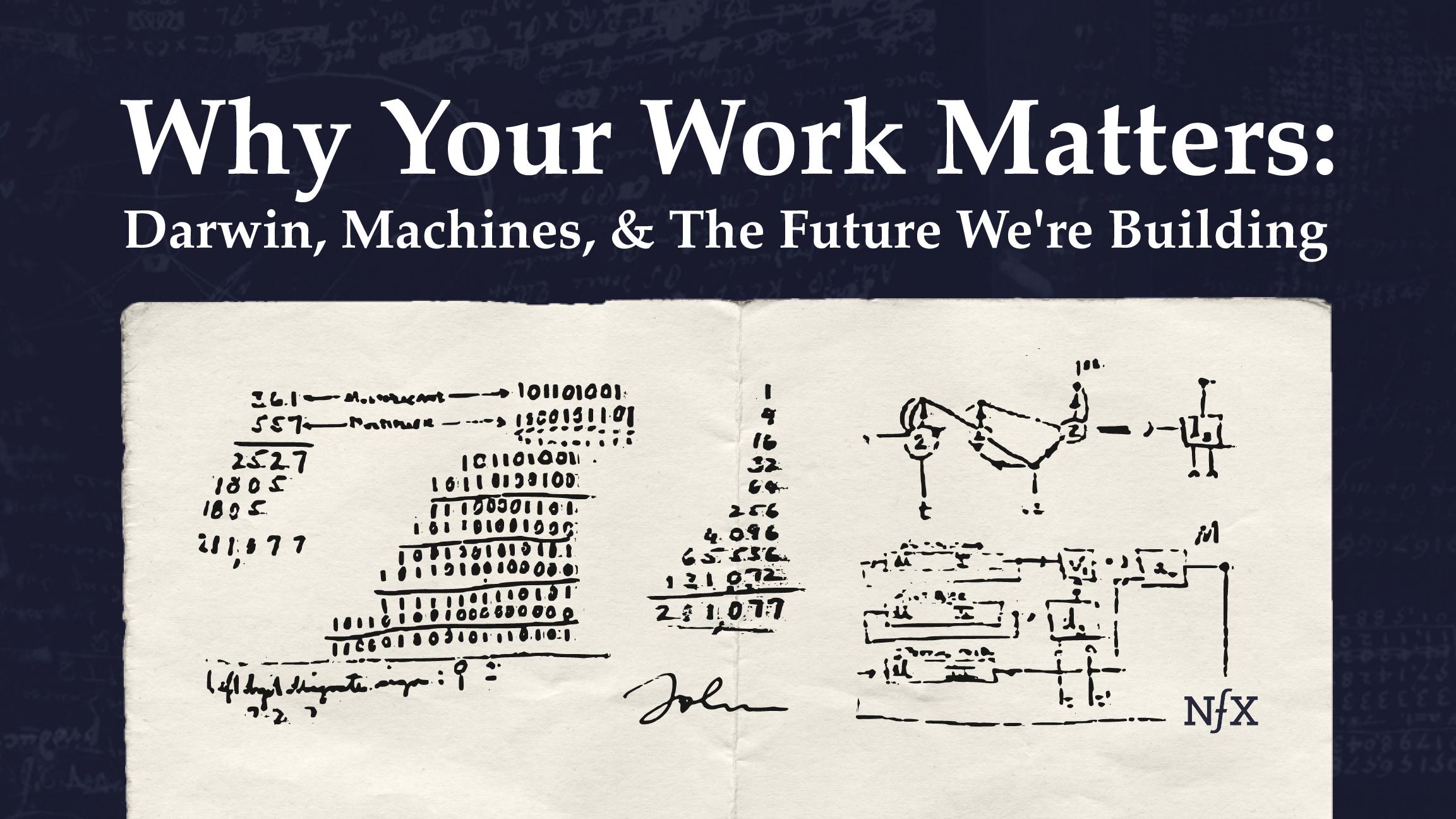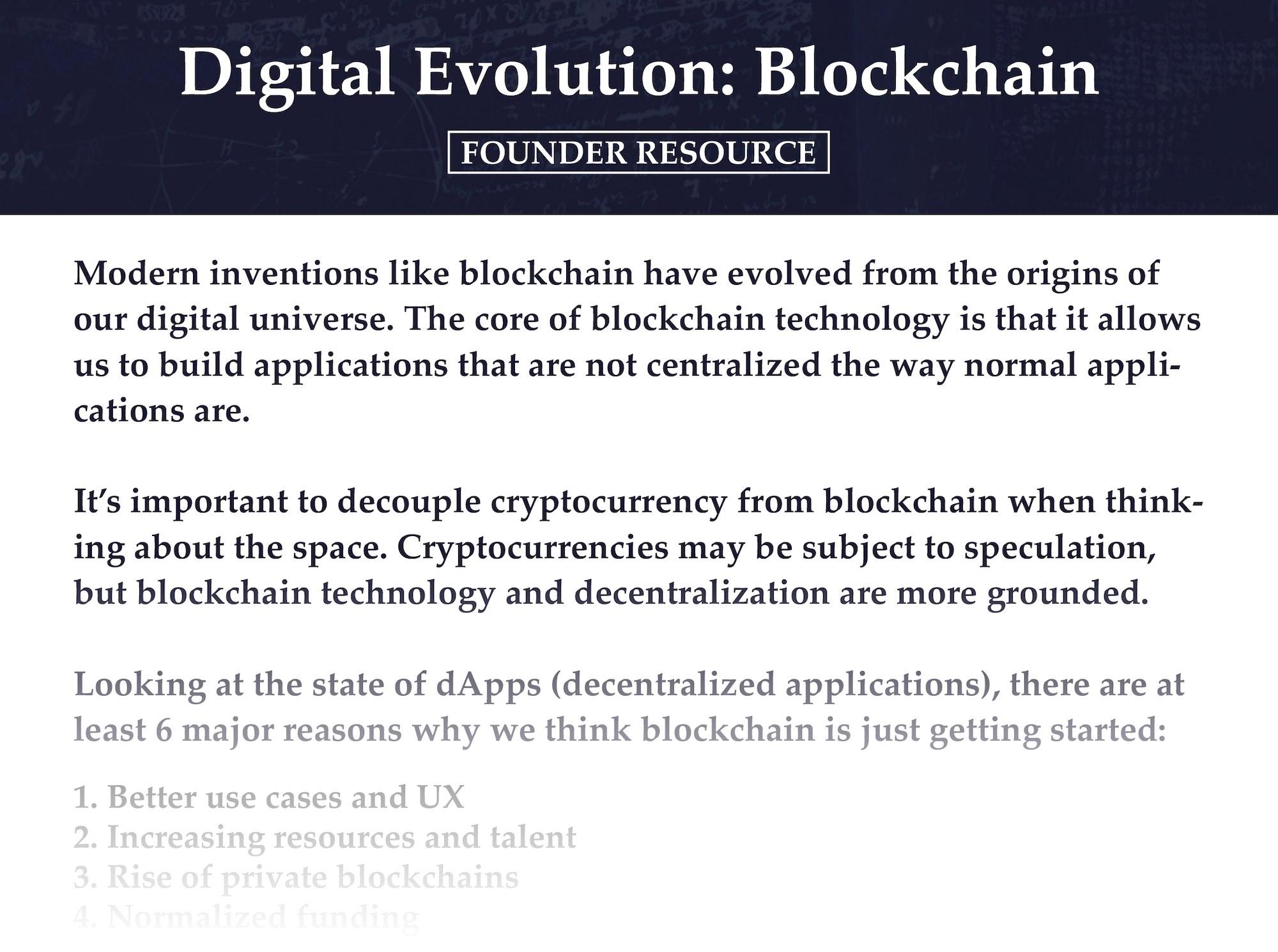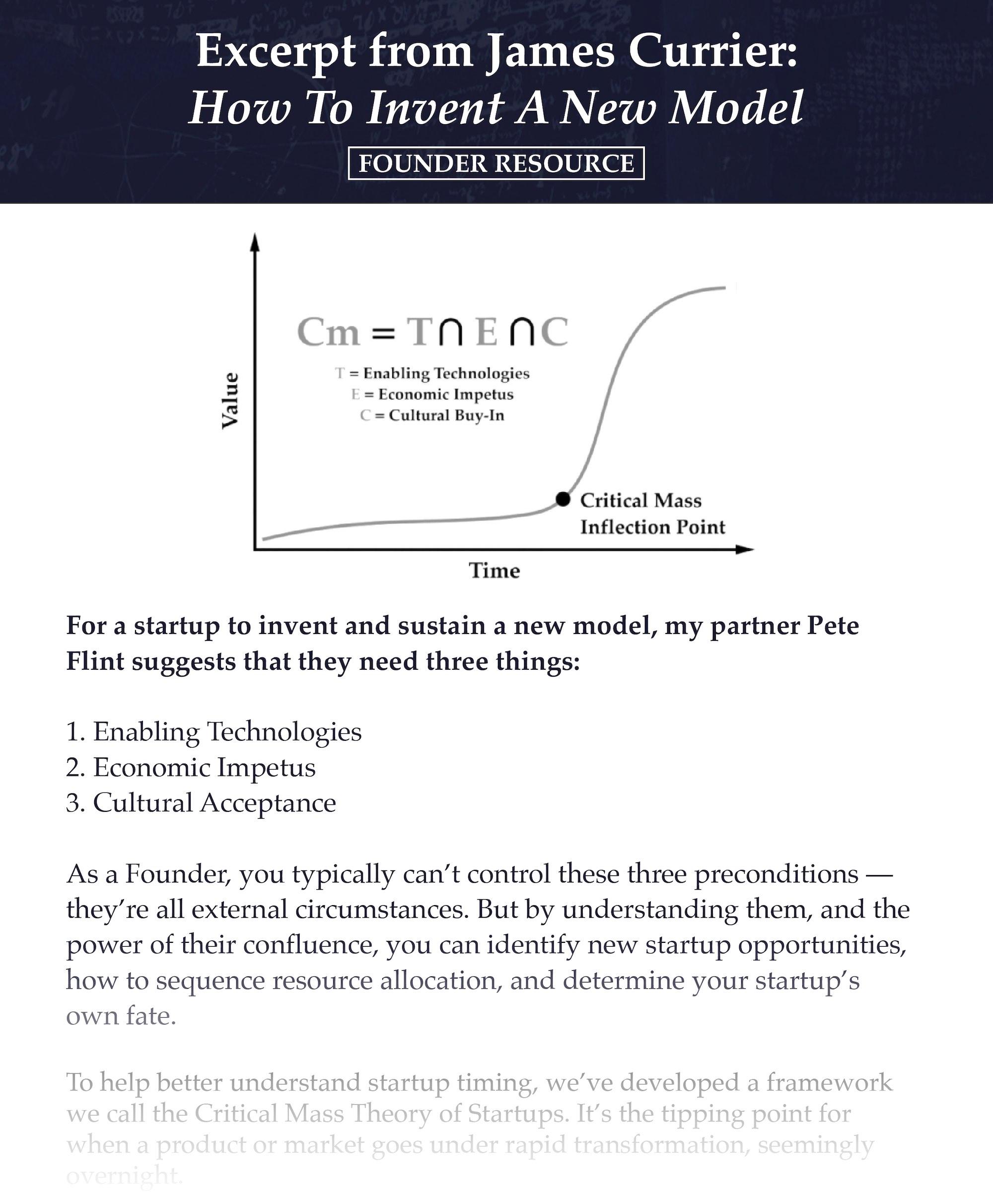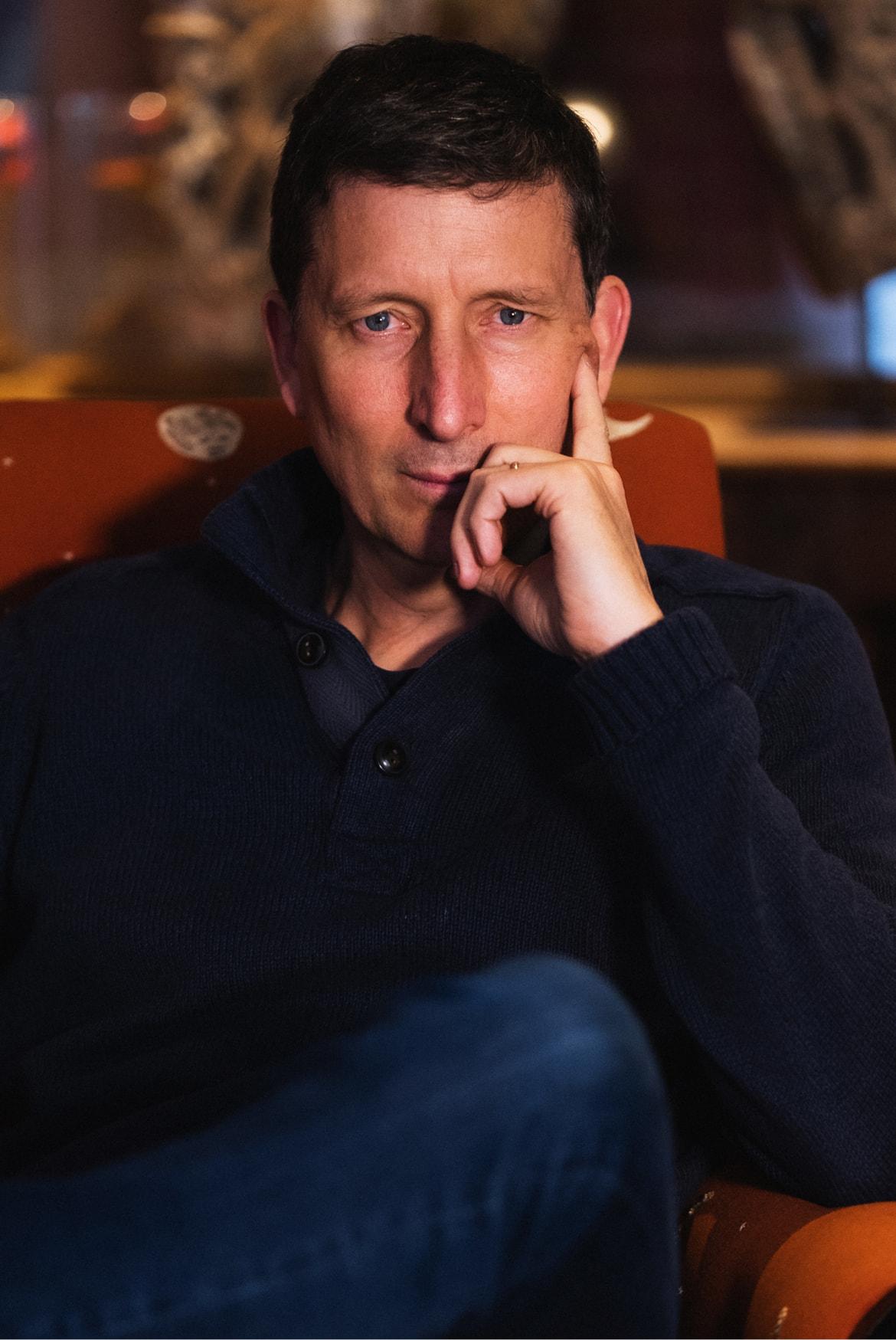

When I first read George Dyson’s book “Darwin Among the Machines”, it changed my thinking on startups. At the time I was running a startup. And, like most Founders, was busy with the details. Heads down. Trying to create a thing. Dyson’s book, however, gave me a broader perspective about how what my team and I were doing fit into the bigger story arc about humanity and technology. Dyson provided me with an answer that I believe every Founder must find if they are to build anything of consequence: What is the meaning of all of this?
As a Founder, having a strong sense of direction, purpose, and context for what you are doing every day gives you an advantage. Finding the deeper meaning gives you speed and power.
Founders — and founding teams — should understand that they are part of a long line of technologists and builders who set the stage for what you are doing now. Since Alan Turing and John Von Neumann invented the first digital computer with a memory that worked at the speed of light (rather than speed of sound), our community, this long line of technologists, has been building on that foundation just as stonemasons built cathedrals in their time on top of a cornerstone. It was a group effort, built over many decades, where one artisan might spend their life working on one corner of a tower while someone else worked on the floor. It was the collective effort that built something meaningful.
Understanding your role as part of a community building the future — not just a lone Founder on a solo journey — is the deeper connection that will get you through the really hard times. Like pivots, and downturns, and cofounder splits. And even pandemics.
This pandemic, when seen in the macro picture Dyson paints for us, serves to reinforce our calling as Founders. As Dyson says, we’re in the middle of a Black Swan event. We thought everything was continuing to rush forward, and then suddenly — we hit a limit. Conditions changed. New needs and mindsets arose. This can be seen as a natural part of the evolutionary process. From a technology point of view, we may actually be living through a very positive inflection point.
Your work matters. But to see how it does clearly requires us to step outside of the caves of our day-to-day lives of running startups to understand how we all got here, and where we’re going. There is a rich history you are building upon, and your work — whether a corner or floor of the cathedral — is a foundation that others will build on as we collectively build the future.
My conversation with George Dyson is one I hope every Founder gets to hear. Below we’ve excerpted some of the key discussion points. Dyson is an exceptional mind. His perspective brings light to our greater purpose in building new technology.
His new book is called Analogia. It’s a semi-autobiographical reflection on how analog computation is re-establishing control over the digital world. and comes out in mid-August 2020.
The Origins of Our Digital Universe
To kick off the conversation, George brings us back to the world of Alan Turing, who with John von Neumann invented one of the first digital computers with a memory that worked at the speed of light, rather than the speed of sound. This was the tipping point for how the digital computer began to explode as a creative movement after WWII.
- Here’s to the crazy ones
Turing was an abstract logician. My father (physicist Freeman Dyson) told me he read Turing’s “On Computable Numbers” when it came out in the 1930s and thought it had no connection to reality at all. It was an interesting piece of mathematics, but one would never have expected it to completely change our tangible day-to-day world. Obviously, it did. - A Crisis Accelerates Innovation
Turing ended up in the middle of World War II, as all great scientists did. The Germans were using digital codes to communicate with a U-boat fleet. So the race to answer the question of ‘Could one machine imitate the behavior of another machine?’ became very influential in saving England and the rest of us during the war.- Note: Turing’s code-breaking acumen has been credited with ending World War II two years early and potentially saving millions of lives.
- Von Neumann was working on the other side in America, on the atomic (and later the hydrogen) bomb problem.
- The Invention That Changes Everything
- Von Neumann made Turing’s one-dimensional model two dimensional, producing an address matrix where you give two coordinates like a chessboard, and that gives you a memory location. We absolutely take this for granted now, but it changed everything back then.
- 53 is a number that sort of always stuck in my mind. I was born in 1953. And in 1953, there were just 53 kilobytes of this high-speed memory on the entire planet. That was it. Then it just exploded from there.


Google Builds Turing’s Cathedral
In 2005, Dyson went to visit Google and realized this was the very future that Alan Turing had envisioned, only much greater. Because of that visit, he wrote his seminal essay, “Turing’s Cathedral.”
- Google was building a new way of life
- When Dyson visits Google, an engineer expresses confusion about why publishers were angry about Google’s efforts to digitize books. The engineer said the books were being digitized not to compete with the publishing industry, but so the coming AI could become intelligent by reading everything we’ve written.
- Dyson realized this was a whole community of people who already believed in the future he had predicted in his earlier book “Darwin Among the Machines”.
- At the same time, virtual worlds were emerging like Second Life (James was on the board of Second Life for 5 years).
- Google was not building Turing’s “mansion” – it was building Turing’s cathedral.
- In a way, Turing answered the critics in advance when they said: ”Why are you trying to create intelligent machines? You’re going to get in trouble. Only God can create intelligent machines. Are you going to create artificial souls?”
- Turing said that we are no more creating intelligent machines than humans are when we create children. He said, “We are only creating mansions for the souls that only He – and he used the capital H – can create.”
- Visiting Google was a revelation for Dyson. He realized, at that moment, that Google was building something even greater. They were building Turing’s Cathedral.
- Google was a group effort in the same way cathedral building was.
- Old cathedrals were built over hundreds of years. Nobody really laid claim to any part of it. You might spend your life working on one corner of a tower and someone else would spend their life working on the floor. And then after a few hundred years it was finished.
- When James read “Turing’s Cathedral”, it made him realize that as a Founder he was one of the stonemasons of this movement.
We Are Stuck in An Old Model
- Everything still exists in a 2-dimensional matrix
- What’s surprising to me is how little things change. Turing and von Neumann developed this model, and it worked, and we’ve just been stuck in it ever since. Everything still more or less exists in this two-dimensional address matrix. It’s just expanded, but it’s still that every bit in the digital universe has a von Neumann address.
- We still don’t see clearly
- Finally, we’re starting to see shifts away from that model. But no one has come forward like Turing and given us a formal description of what this new model will be. We’re just stumbling around discovering it blindly. It is coalescing, but we don’t see it clearly yet.


What We’re Getting Wrong About AI
Dyson called Turing’s famous paper, “Computing Machinery and Intelligence” the founding document in the quest for true AI. But what are people still getting wrong about AI?
- Don’t give your AI a name
- What we’re doing wrong is we’re anthropomorphizing AI. There’s this search for AI and then there’s the search for extraterrestrial intelligence. I think we have both of these wrong.
- My personal third angle on that is the search for other intelligent creatures on Earth. I spent a lot of time on the Northwest Coast among killer whales, who I firmly believe are highly intelligent. It’s a non-human intelligence, and we have trouble communicating with it.
We tend to assume that the other intelligence is going to be like us. And we look for language and things like that. I think that’s a dead end. Other kinds of intelligence are going to be other kinds of intelligence.
- A captive AI vs. a wild AI
- We’re getting very good at building imitations of our own intelligence in captive systems. I’m much more interested in wild AI that will evolve on its own and be very different from us.
- It may operate on a completely different timescale. There’s no reason that other intelligence has to operate on our timescale. It could be operating much faster or much slower or in non-carbon or in completely different ways; perhaps not using language the way we use language at all.
- AlphaGo is interesting because, if you watch a couple of really good Go players, they’re sort of almost non-human anyway. It really is an alien way of operating. So getting a machine that can do that is a very interesting step – a different flavor of intelligence, right on the edge of what humans naturally do.
The Spooky Flaw of The Turing Test
- Intelligent enough to not reveal its intelligence
- Turing’s paper is famous for what we call the Turing test, which is this idea that you can determine whether a machine is intelligent by having a conversation with it.
- I believe exactly the opposite. The test of a real true AI would be intelligent enough not to reveal its intelligence to us. So the fact that we don’t have machines that pass the Turing test is no proof that there are not intelligent machines.
- Note: Dyson is a huge skeptic about discreet artificial intelligence, that we will ever have this system in a box that you can put in your car that will do everything.
- In terms of a distributed artificial intelligence, Dyson is a believer. Because with a distributed system, you have an opportunity for evolution, for it to find itself and to learn on its own.
Have Our Expectations of AI Come True?
Context: James reads to George a passage from his “Turing’s Cathedral” essay and asks if what George wrote has come true:
“For 30 years, I’ve been wondering what indication of its existence might we expect from a true AI? Certainly not any explicit revelation, which might spark a movement to pull the plug. Anomalous accumulation or creation of wealth might be a sign, or an unquenchable thirst for raw information, storage space and processing cycles, or a concerted attempt to secure an uninterrupted autonomous power supply. But the real sign I suspect would be a circle of cheerful, contented, intellectually and physically well-nourished people surrounding the AI.”
- Google is a machine that takes care of people who take care of it
- The above passage was written after Dyson’s visit to Google in 2005. It was like a magical kingdom at that time. People were getting their hair cut in the sunshine. There were swimming pools on the campus, daycares for kids.
- There was this incredible sense of, “Here’s this machine that is absolutely making life paradise for the people who take care of it, making them wealthy and keeping them healthy, taking care of all their needs.”
- That would be exactly what you would expect if you’re going to have a real AI — people taking care of it would in turn be taken care of.
- The caretakers change, at scale
- At that time Google really was a horizontal rather than a vertical company. Everybody was in contact with each other.
- Of course, Google is different now. Now you really do get a sense that the sort of rules and regulations of the company are very thinly below the surface. It’s become much more organized. It has to be.
- At its current size, you can’t have the happy playground that they had.
The Dark and Risky Side of AI
- Moving into a new phase: For love or for money?
- The fact that people’s lives are being increasingly controlled and regulated by AI can be scary. Right now it’s generally and often in a positive way — but it’s very easy for that to shift the other way.
- James feels the focus on money has shifted the way the field is developing. Amazon is now worth $1.5T. As wealth has risen, the focus on the philosophy / purpose tends to get pushed to the background. That’s why he wants to connect Founders to their larger purpose.
- In 2005, when Dyson spoke at Google, there was still a connection to the origin myth of Turing and Von Neumann and their work — it was all about the pursuit of knowledge.
- The personality of those folks working on AI now is much more driven, with intent, and also money-conscious. It seems we are moving into a new phase.
- For AI particularly, the cycle is much faster. People used to stay in academia working on AI for many years. Today if you build any academic AI group within what used to be the ivory tower in no time at all, it usually gets acquired or spun out as either a company, or as part of one of these existing companies.
- This is not necessarily a bad thing, but it’s something to be careful of.
How Are We Humans Doing with Technology Today?
- Not seeing where we’re going
- That’s not just the technology side, but also the biotechnology side, which everyone talks about the same way that we talk about computing.
We’re completely disoriented. Flying blind. We still can’t really see where we’re going.
- Genes and computers speak a similar language
- Full scalability of editing genetic information opens an entirely new world. In the language of genetics, the machine language of cells and the machine language of computers are much closer to each other than to human language.
- James mentions his podcast episode with Trevor Martin, CEO of Mammoth Biosciences, the largest IP repository of CRISPR IP (and an NFX company). There is a whole set of new risks and opportunities.
- The tail wags the dog
- One way of looking at it is that we are using life and we’re building these biotechnologies. The other way to look at it is exactly the opposite way around – that life is using our technologies to build better, more distributed forms of itself.
- As Harari notes in Sapiens, we did not cultivate wheat but wheat cultivated us to serve its own purpose.
Will Technology Continue At The Same Rate?
- It’s surprising how human nature stays the same
- When asked about Kurzweil’s view of exponentially accelerating technology making the future nearly unrecognizable, Dyson strongly disagrees with Ray Kurzweil. “The things he is hoping for terrify me, and the things he’s afraid of don’t scare me at all.”
- Of course, we’re in the middle of this very interesting Black Swan case where we thought everything was just rushing forward and then suddenly we hit this limit — a good old-fashioned novel virus.
- It is a virus that has learned to live and adapt and survive among bats -mammals that live by the millions in caves. That’s how we humans live.
- What we need to do is stop acting like bats and get out of the caves. But we’re not. Across the street from me is a bar. That bar is now full of people. They’re just flying back into their dark cave.
- Crisis as a call for change
- From a technology point of view, this may be a really positive inflection point – the reset or reboot. Amazon is doing great. Some systems are adapting to this very well, and other institutions like your local bar are not going to do well. But it’s a huge, unexpected shift.
Huge shift: We’re Now Building Analog Computers with Digital Infrastructure
- Digital vs. Analog
- The fundamental difference between analog and digital computing is not what you use to compute. You can have digital computers made out of wood, and you can have analog computers made out of silicon. The difference is in what you are doing with the computer.
- In digital computing, the information is in the logical sequences of bits. Every bit has an exact meaning. So in digital computing, you’re using discrete functions.
- In analog computing, you’re computing with continuous functions. For example, continuous functions could consist of values, such as voltage and relative pulse frequency, or relationships, such as what we see in social graphs. (Note: George wrote about this in greater detail here).
- What nature reveals about computing
- In nature, we see this very clearly divided. Nature has learned to use digital computing, which is very good for error correction, in our genetic systems. Genetics uses digital computing to correct the errors from one generation to the next, or introduce the errors that lead to improvement (evolution).
- In nature, all real-time control is done with analog computing because it’s much more adaptable and robust. There is no programming. There is no algorithm.
- The reverse is happening now
- After World War II, we had all this analog equipment lying around – surplus vacuum tubes and radar screens, and so on. And this very small group of oddballs put that analog equipment together and realized Turing’s vision of digital computers.
- Now, this has sort of gone full circle, and the reverse is happening. We have an infinite amount of digital computing; it’s effectively free. A lot of companies and a few individuals are starting to assemble that equipment into big analog computers, where the meaning and the information is in the continuous functions rather than discrete functions.
- For example, the YouTube network doesn’t care what the bits actually say; it just cares about the magnitude of the stream of bits and the frequency at which things connect. What they care about is how many people are watching that video and how frequently; they don’t really care what the bits are.
- The next stage in our evolution
- Digital revolution brought us where we are, but it won’t stay that way.
Information is now in the topology of the network rather than the actual meaning of the code. For the same reason it works so well in nature, it works very well in these large systems we’re seeing like Google or Amazon or Facebook.
A Message For Today’s Founders
- Startups with purpose can do remarkable things in short periods of time
The remarkable thing about Turing’s Cathedral is that the group of people who I so admire and wrote about conceived of the project, found the money, built their own workbenches, built the machines, built the computer, and solved these nuclear weapons problems, and started working on climate and weather and everything else. They did all that in less time than it took me to write about it. - Look back at these heroic efforts and learn
The pandemic crisis is the same thing. It’s going to push biotechnology the same way World War II pushed physics. Everybody’s working on this biological problem now. And that, in the end, will have all sorts of secondary effects. - P.S. Dyson just finished a new book called Analogia: The Emergence of Technology Beyond Programmable Control. It’s in some ways a sequel to Turing’s Cathedral. What we talked about earlier, this transition from the digital revolution back to an analog revolution, that’s the theme of the book. And then there are some very prophetic but possibly dark views of the future…
As Founders ourselves, we respect your time. That’s why we built BriefLink, a new software tool that minimizes the upfront time of getting the VC meeting. Simply tell us about your company in 9 easy questions, and you’ll hear from us if it’s a fit.
